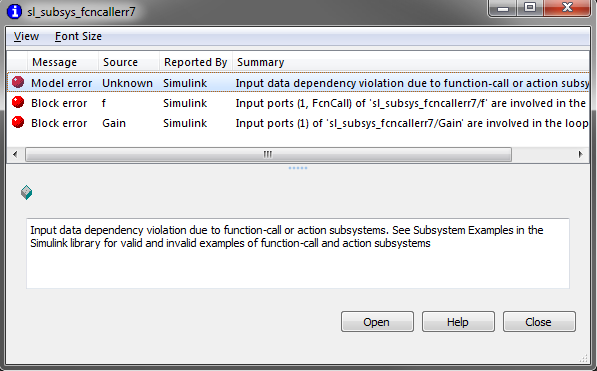Data Dependency Violation Errors and Subsystem Semantics
Did you ever receive a "data dependency violation" error message from a Simulink model?

I will try to explain why this happens and what you need to do to avoid this error by introducing my favorite set of Simulink examples.
Function-Call Subsystems
To begin, let's explain how aFunction-Call Subsystemis executed.
In the following example model, I display the blockssorted order. You can notice that the Function-Call Subsystem is noted "0:F{1}". The "F" means that this subsystem is Function-Call and you should look at the call generator to see its sorted order. In this case, it is "0:1".

If we generate code, we can see that the Function-Call Subsystem is executed in that order:

Invoking a Function-Call Subsystem from an Atomic Subsystem
Now let's place the Function-Call Generator inside an Atomic Subsystem.

The same principle as in the previous example applies. Since the source is now inside an Atomic Subsystem, the Function-Call Subsystem is pulled inside the Atomic Subsystem.

Data Dependency Violation
Now, what happens if the Function-Call Subsystem takes an output of the Atomic Subsystem as input.

If you try to update this model, you will receive the following errors:
Input data dependency violation due to function-call or action subsystems. See Subsystem Examples in the Simulink library for valid and invalid examples of function-call and action subsystems
Input ports (1, FcnCall) of 'fcnCallExample1c/FcnCallSS' are involved in the loop
Input ports (1) of 'fcnCallExample1c/GainBefore' are involved in the loop
I hope that based on the previous example, you can visualize why this semantics is impossible. On one hand, I specified thatAtomicSSis atomic, includingFcnCallSSthat gets pulled in as shown above. On the other hand,FcnCallSSneeds the output ofGain3. ButGain3cannot execute untilAtomicSSis completed.
What to do?
To get help on this topic, search for the Simulink example titledSimulink Subsystem Semantics. It can be opened by usingsl_subsys_semantics.

This example is a collection of models showing good and bad practices for the different types of subsystems available in Simulink. For function-call subsystems, you will find a large set of models. The green examples show the correct way to connect function-call subsystems and the red examples explain common errors.

For the example above,sl_subsys_fcncallerr7is the one you are looking for.
Now it's your turnI hopesl_subsys_semanticswill be as useful for you as it is for me! Give that a look and leave us acomment below.
- Category:
- Code Generation,
- Debugging














 Cleve’s Corner: Cleve Moler on Mathematics and Computing
Cleve’s Corner: Cleve Moler on Mathematics and Computing Loren on the Art of MATLAB
Loren on the Art of MATLAB Steve on Image Processing with MATLAB
Steve on Image Processing with MATLAB Guy on Simulink
Guy on Simulink Deep Learning
Deep Learning Developer Zone
Developer Zone Stuart’s MATLAB Videos
Stuart’s MATLAB Videos Behind the Headlines
Behind the Headlines File Exchange Pick of the Week
File Exchange Pick of the Week Hans on IoT
Hans on IoT Student Lounge
Student Lounge Startups, Accelerators, & Entrepreneurs
Startups, Accelerators, & Entrepreneurs MATLAB Community
MATLAB Community MATLAB ユーザーコミュニティー
MATLAB ユーザーコミュニティー






Comments
To leave a comment, please clickhereto sign in to your MathWorks Account or create a new one.